
|
|
Once again I bring you another historical write up from the far reaches of Montana, and like my previous write up this is going to be a long one. From nuclear weapons to sovereign citizens and mock bombing runs to legal battles, the ghost town of St. Marie, formerly Glasgow Air Force Base, has a long and rocky history.
In April of 2022, I found myself on a long drive across the empty prairies of eastern Montana. I was on the way back to Wisconsin after my seasonal job had reached its end, and decided to make a detour to the largest ghost town in the region. The sky was a thick gray overcast and a frigid wind howled for miles across the flatlands with nothing to slow it down. As I pulled off the lonely highway into St. Marie I was greeted by block after block of decaying houses and overgrown streets. I slowly drove around the town and a lone tumbleweed blew across my path. It seemed a little on the nose for a ghost town exploration, but I guess cliches exist for a reason.

Photo 1: One of the many residential streets in St. Marie lined with abandoned houses. There are roughly one thousand homes in St Marie, but less than a third are currently occupied.

Photo 2: A tumbleweed looms menacingly in the darkened hallway of an abandoned house.

Photo 3: The interior of one of the abandoned houses. There was very little graffiti, and most appeared almost as if though they had never been lived in at all.
Forty miles south of the Canadian border sits the crumbling remains of Glasgow Air Force Base, one of America’s many military ruins. Originally named Glasgow Army Air Field, it originated as a training ground for American B-17 bomber crews bound for the European Theater in 1942. The last training squadron departed for England in the fall of 1943 and the base was converted into a POW camp from 1944-1946. Shortly after the end of the war the base was declared surplus and turned over to the War Assets Administration, under which it sat empty for ten years.
In 1955, the US Air Force took over the site and reactivated it two years later as Glasgow Air Force Base. Operating first under the authority of the Air Defense Command, it originally housed fighter and interceptor squadrons to act as a deterrent against Soviet bombers approaching through Canadian airspace. The airbase was transferred to the Strategic Air Command in 1960 and was expanded to house part of America’s nuclear-capable strategic heavy bomber fleet.

Photo 4: The main lobby of the on-base hospital. The hospital was one of the largest and most interesting abandoned buildings in the town.

Photo 5: One of the many patient rooms in the hospital wards. Most had between one and four beds.

Photo 6: One of the several surgical suites in the hospital. Though structurally sound, the hospital has been heavily damaged by mold as this picture shows.
The Great Plains were a popular location for facilities to house nuclear weapons and Glasgow AFB was only one of several military sites in Montana used for that purpose, including the Minuteman missile farms and the SAFEGUARD anti-ICBM program. Military doctrine favored the Great Plains for such bases because they are deeply rural, low population areas. It was hoped that they’d draw fire away from major cities during a nuclear exchange since nuclear weapon sites would be a high priority target to the Soviets.
Major units assigned to Glasgow Air Force Base include the following:
- 476th Fighter Group
- 13th Fighter-Interceptor Squadron
- 4141st Strategic Wing
- 91st Bombardment Wing, 322nd and 326th Squadrons
- 907th Air Refueling Squadron
- 4300th Air Base Squadron
The fighter groups flew F-101 Voodoo fighters, the bombardment squadrons flew B-52 heavy bombers, and the Air Refueling Squadron flew KC-135A air tankers.

Photo 7: Based on the stirrups attached to this chair it's likely that this room was either the delivery room or gynaecology ward, possibly both.
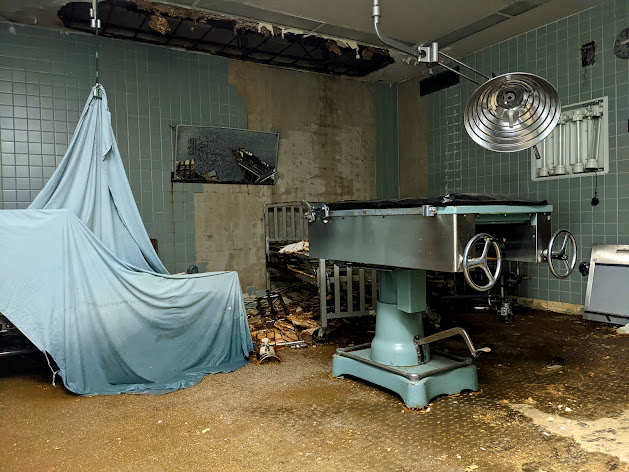
Photo 8: Another surgical suite. Based on the small size of the operating table and beds, I suspect this was the pediatric surgical ward.

Photo 9: Yet another surgical suite, this one in slightly worse shape.
With over 7000 airmen and their families stationed at Glasgow AFB, the airbase became a town in and of itself. Boasting a school, hospital, chapel, post office, library, cinema, and row upon row of modern duplex townhouses, Glasgow AFB was a thriving military town. All those soldiers needed places to spend their pay, and plenty of contractors and businessmen moved to the area to provide just that. Though the exact command assignments and units changed over the following decade, the presence of the 91st Bombardment Wing acted as a stabilizing constant on the airbase and local economy.
This all changed in May of 1968 when the 91st Bombardment Wing was declared not tactically operational and taken off alert status due to the high costs of maintenance. The unit was dissolved and reformed as the 91st Strategic Missile Wing and was subsequently transferred to Minot Air Force Base in North Dakota, where it continues to operate the Minuteman III program to this day. Without its strategic bomber fleet and with March Air Force Base in California able to pick up the slack, there was little reason to keep Glasgow Air Force Base open and the US Air Force deactivated the base three months later.

Photo 10: A piece of equipment in the radiology department. A patient would lie upon the raised table portion of this machine, which was likely used for chemotherapy or some other form of radiological treatment. Technicians conducted procedures from behind shielded section of the room just out of frame.

Photo 11: An exterior view of the hospital. Like many buildings on the base it was built wide and low to the ground, possibly to increase its resilience against a nuclear blast wave. Of course, it's also possible that they simply didn't want to deal with the inconvenience of elevators in a hospital if they didn't need to.

Photo 12: The exterior of the elementary school. Like the hospital, it was built wide and low to the ground, though with far more exterior windows.
The economy of the surrounding area collapsed nearly overnight. Thousands of people moved away from Glasgow in 1968 alone, by 1970 the emigration rate of the nearby town of Glasgow (for which the base was named) had reach 33%, and by 2013 the population had fallen from 7900 to less than 250. The citizens of the surrounding area hadn’t anticipated that the economic boon of the airbase wouldn’t last forever, and they were woefully unprepared when it was suddenly taken away from them.
The US Army briefly attempted to use the shuttered base as a staging ground and supply depot for the SAFEGUARD anti-ICBM complex they were building about 200 miles west, but when the SALT I treaty forced the US to limit itself to only one such complex, construction was halted and the partially built Montana complex was abandoned in favor of the one in North Dakota. In 1971 the Strategic Air Command began using Glasgow AFB as a force dispersal base, where soldiers and equipment from other bases were housed to spread them out and minimize the effects of any one nuclear strike, but the base did not have any actual units of its own stationed there and remained a shell of its former self.

Photo 13: One of the rooms in the elementary school, possibly a small classroom.

Photo 14: Like many elementary schools, this one combined the gymnasium, cafeteria, and auditorium into one multipurpose room to save on space.

Photo 15: A partially collapsed hallway in the elementary school. This building was the most structurally damaged building in town by far.
The base was finally closed for good in 1976, and sometime around 1980 the US Air Force put the base up for sale to private investors. One such buyer was Boeing, which bought the airfield section of the base and renamed it Glasgow Industrial Airport. In 2018 Boeing expanded its holdings to include much of the base itself surrounding the airfield, though it appears little has been done yet with this acquisition. To this day Boeing uses this remote private airport to conduct tests on new aircraft systems including cold weather resistance, noise level, and navigational equipment through one of its subsidiaries, the Montana Aviation Research Company.
Meanwhile, the bargain discount price for the townhouses in the residential section of the base caught the eye of a former US Air Force officer named Pat Kelly in the 1980s. Kelly bought up hundreds of houses with the intention of turning the town into a retirement community for military veterans. A group of veterans moved in, and together they named this fledgling township St. Marie.

Photo 16: A view of the base chapel, taken from the altar stage. This building was the most pristine and least decayed abandoned building in the entire town.
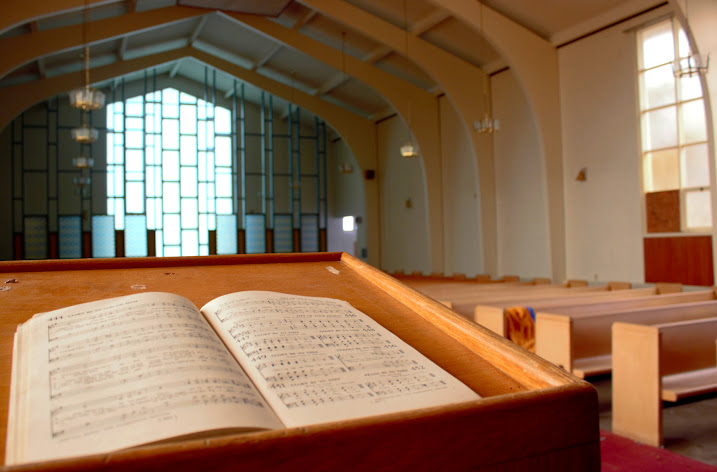
Photo 17: A songbook still on the pulpit of the chapel.

Photo 18: A view of the altar stage taken from the back of the chapel.
Unfortunately, it’s likely that St. Marie was doomed from the start. A town needs more than a few residents- it needs schools, businesses, jobs and entertainment. In short, it needs an economy. Pat Kelly found himself unable to jump start the dead economy of St. Marie, leading to a vicious self perpetuating cycle- the town wouldn’t grow without more people, and more people wouldn’t come unless the town grew. St. Marie quietly limped along in this fashion for a few decades. Property taxes went up and Kelly became delinquent on the back taxes for hundreds of homes, but the county treasurer didn’t even bother to foreclose on them because “nobody wants them.”
That all changed in the fall of 2012, when three strangers came to town. They claimed to be representatives of a company called DTM Enterprises, looking to invest in housing for workers from the nearby Bakken oilfields. Kelly, who had been searching for decades for a way to revitalize the town’s economy, initially welcomed them with open arms- going so far as to host them in a private guest house. He hoped that they’d be the cure for St. Marie’s economic woes, the solution to restore the township to its former glory. He couldn’t have been more wrong.

Photo 19: Exterior view of the chapel.

Photo 20: Exterior view of the old post office (left). At some point after the closure of the base the post office moved to a different building nearby, where it remains active to this day.

Photo 21: Interior of the post office. An old sign in a back corner that reads "North Valley Shop N' Save" indicates it may have been used as a grocery store at one point as well.
Montana law allows for a person or company to purchase tax delinquent properties from the county for the price of just the back taxes, often pulling the rug out from under the previous owner. That is exactly what DTM Enterprises did to Kelly, paying the $187,000 he owed on nearly 400 houses. This purchase was the opening shot in a legal conflict that lasted for years.
As it turns out, DTM Enterprises was a front for the sovereign citizen movement. Sovereign citizens don’t consent to the laws of the United States, and thus believe those laws don’t apply to them. They’re infamous for a wide variety of legal stunts they use in an attempt to make their point, and the FBI has referred to them as “paper terrorists” for their tendency to use frivolous lawsuits and perceived legal loopholes to clog up the court systems and run non-sovereign citizens out of town. Popular sovereign citizen activities include filing lawsuits over drivers licenses, battling the IRS over taxes, attempting to take over entire communities via bogus liens, and occasionally building armed compounds to violently fight the government.
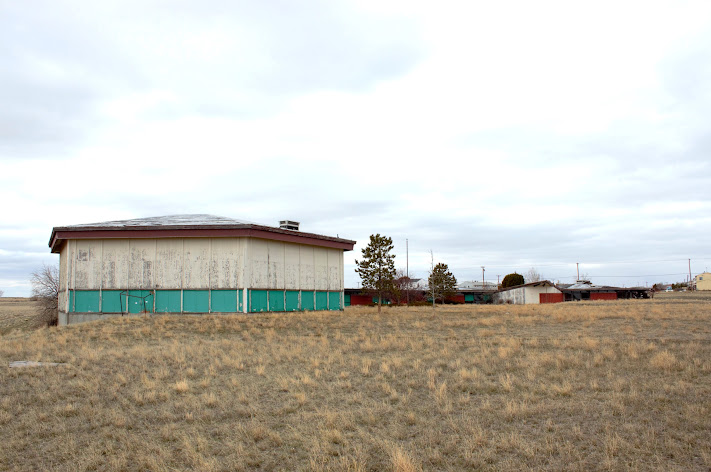
Photo 22: I'm not entirely sure what this building was, but I suspect it was the local middle school. Like the elementary school and the hospital, much of this building was built wide and low to the ground.

Photo 23: A hallway in the middle school. St. Marie had no high school and high school aged students likely attended class in the nearby town of Glasgow, roughly 30 miles away.
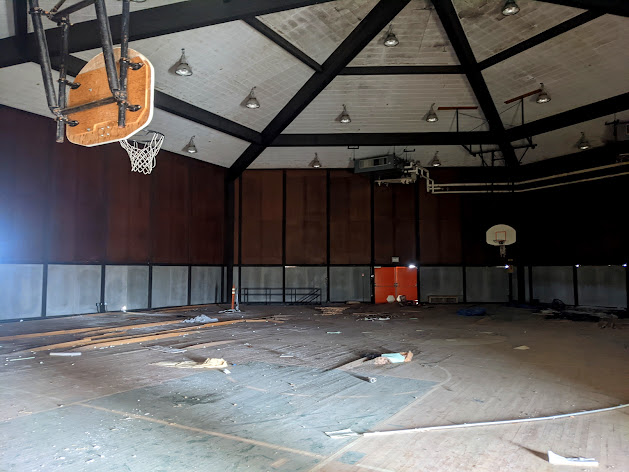
Photo 24: The middle school gymnasium.
Two of the leaders of this particular sovereign citizen sect began to escalate their efforts to take over St. Marie. One of them, Terry-Lee Brauner, had been involved in the movement for decades. He’d previously gotten into a protracted legal battle with the IRS over $1 million in unpaid taxes in the 90s, followed by a failed attempt to become a sheriff in Washington State under the Constitutionalist banner in 2010. True to form, it didn’t take long for Terry-Lee to get into legal trouble in St. Marie.
In 2013 he sent a 25 page manifesto to local government officials explaining why he felt he didn’t need a license or insurance to drive, much of it hinging on his self-identification as a “sovereign citizen of the Republic of Montana” as opposed to being a citizen of the “municipal corporate state of MONTANA.” Apparently writing it in all capitalized letters made it a different legal entity, or so he believed. The local sheriff was not convinced, and Terry-Lee spent a brief stint in jail a few weeks later for driving without a license.

Photo 25: The base had its own cinema to entertain service members and their families with movie showings.

Photo 26: The back row of seats in the cinema were labeled "Alert Force Only." An alert force in the military is a group of soldiers expected to maintain combat readiness at all times, so positioning them in the back of the cinema allowed them to scramble quickly if needed without getting caught up in the crowd.

Photo 27: Exterior view of the cinema.
As soon as he was out of jail, the sovereign citizens attempted to declare St. Marie to be a blighted community so that they could use eminent domain to take it over. Given that only the federal government can use eminent domain under Montana law, they failed. Next, they attempted to use the hundreds of houses they owned as proxy votes to stage a hostile takeover of the local property association owners board. That too failed when questions over membership fees, and whether each house got a vote or just each homeowner, were put to rest against their favor.
No stranger to protracted paperwork battles and dubious legal moves, the hostile takeover attempts continued. The sovereign citizens attempted to break away from St. Marie and form their own homeowner’s association, which never got off the ground. Then they filed hundreds of lawsuits against the residents of St. Marie over utilities ownership, which cost each resident no small amount of money in court fees to defend themselves and forced a few to move out as they were unable to pay the legal costs. This was followed by an attempt to rewrite the protective covenants of St. Marie. The battle spread from the courtroom to the local newspaper, where Kelly and Terry-Lee verbally duked it out in fiery opinion pieces as the leaders of their respective factions.

Photo 28: A sign marks the boundary between the section of town open to the public and the section owned by Boeing.
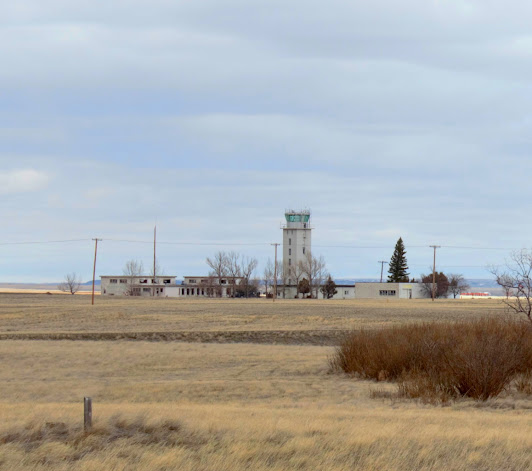
Photo 29: Though it's hard to tell, it appears from a distance as though the air traffic control tower and part of the the airport is abandoned. Unfortunately I didn't get the chance to explore this section of St. Marie.

Photo 30: The old Glasgow Air Force Base barracks, which are part of the section owned by Boeing. I was not willing to risk getting caught trespassing on a military contractor test site, though I won't deny it was tempting.
The prospect of Terry-Lee and his accomplices successfully converting St. Marie into a sovereign citizen enclave did not sit well with the residents. Just few years earlier, a neo-nazi tried to use similar methods to take over the nearby ghost town of Leith, North Dakota so he could convert it into a white supremacist enclave. Even earlier than that, a group of sovereign citizens calling themselves the Montana Freemen made an attempt in 1996 to declare their own independent township that ended in an 81 day armed standoff with the FBI. Terry-Lee had publicly expressed various white supremacist and antisemitic ideas alongside his sovereign citizen doctrine on previous occasions, and these previous conflicts were remembered well by local residents who didn’t like the pattern they saw.
Terry-Lee claimed he had no intention of turning St. Marie into a sovereign citizen enclave, and said he was merely a businessman interested in making money off the oil boom who wasn’t afraid to use underhanded legal methods to do it- despite running local newspaper articles and holding talks preaching sovereign citizen rhetoric and theory. Either way, when the oil boom dried up in 2015 the legal battles over St. Marie ended in a stalemate.

Photo 31: The interior of the old community center. It was used as a community thrift shop at some point in the last decade or so, but didn't appear to be in use anymore.

Photo 32: Exterior of the community center (left).

Photo 33: A sign posted at the entrance to the town welcoming visitors with an abandoned neighborhood in the background. Based of old photos it appears that this sign is relatively new, installed within the last few years.
Though the legal battle for the town’s future had ground to a halt, the courtroom drama continued as both sides were forced to reckon with the cost of their conflict. Terry-Lee was caught in 2017 bypassing water meters to illegally tap water mains without paying utility fees, and he was sentenced to six months in prison for theft- a conviction he fought all the way up to the Montana Supreme Court, which upheld it. Meanwhile, one year later Pat Kelly was found liable for over $12 million in fraud and breached contracts he had accrued from investors while trying to revitalize the economy and fight off the sovereign citizen takeover in court. With both factional leaders unable to continue the fight the future of St. Marie remains uncertain to this day, locked in an uneasy cold war much like the one that led to its founding.

Map 1: A map I made of the base and town, based off a Google Maps screenshot. Unfortunately I was only able to explore the blue sections, but I hope to return someday to explore the rest.
It was in the fallout of these events that I drove into St. Marie. I spent much of the day exploring the residential sections of the base, but I was turned back from the airfield itself by the signs Boeing posted warning of 24/7 surveillance and prosecution. The fence would have been easy to hop, but I’d already been caught on camera by Homeland Security exploring a derelict radar station turned covert surveillance site three months prior, and I was reluctant to try my luck with a major defense contractor testing site so soon after catching the attention of the DHS once already. I later learned that all I had to do was ask the right person to gain access, but unfortunately I was long gone from St. Marie by the time I discovered that. Still, the ruins I was able to see more than satisfied me. The history of St. Marie is almost as interesting as the ruins of the town and I certainly wouldn’t mind returning one day to explore the airfield itself.
All in all, not a bad way to spend my 24th birthday.
Sources
SAC Bases: Glasgow Air Force Base
Military History Fandom: Glasgow Air Force Base
Treasure State Lifestyles: Glasgow Air Force Base
Wikipedia: Glasgow Industrial Airport
Spectral Geography: Boeing's Montana Playground
Wikipedia: St Marie, Montana
The Missoulian: Ghosts of Glasgow
Billings Gazette: Anti-Government Group Clashes With Hi-Line Retirement Community
Southern Poverty Law Center: Fear and Loathing In Montana
State v. Terry-Lee
Glasgow Courier: Kelly Found Liable For Fraud

"Sorry, I didn't know I'm not supposed to be here," he said, knowing full well he wasn't supposed to be there.
| |
Fantastic as always

| |
Really excellent set and write up! Appreciate the thorough historical foundation.

https://www.flickr...62837453@N07/sets/
http://www.tfpnj.blogspot.com | |
Now that's a place I'd like to visit. Very thorough write up and great pics.

unlimited nights and weekends | |
Amazing place, great photos and great write-up. Nicely done.

"The time of getting fame for your name on its own is over. Artwork that is only about wanting to be famous will never make you famous. Fame is a by-product of doing something else. You don't go to a restaurant and order a meal because you want to have a shit."
-Banksy
The work of FuriousD: https://www.flickr...photos/opdendries/ | |
What an amazing post! I love the pis and all the info you provided. Thank you so much for posting this!!!

| |
Posted by Aran
The fence would have been easy to hop, but I’d already been caught on camera by Homeland Security exploring a derelict radar station turned covert surveillance site three months prior, and I was reluctant to try my luck with a major defense contractor testing site so soon after catching the attention of the DHS once already.
|
Do you feel comfortable elaborating?

| |
Nice writeup and explore man, thank for taking the time to do this.

Il y a toujours un moyen. | |
Posted by BoredFun27
Do you feel comfortable elaborating?
|
Unfortunately, not in a public thread. Honestly I've probably already said too much, but the guy who caught me was chill so I'm probably being overcautious.
[last edit 7/22/2022 2:00 AM by Aran - edited 5 times]

"Sorry, I didn't know I'm not supposed to be here," he said, knowing full well he wasn't supposed to be there.
| |
Well done Aran.

RIP Blackhawk |
Add a poll to this thread
This thread is one of your Favourites. Click to make normal.Click to make this thread a Favourite.

| This thread is in a public category, and can't be made private. |
Powered by AvBoard AvBoard version 1.5 alpha
Page Generated In: 281 ms
|
|

